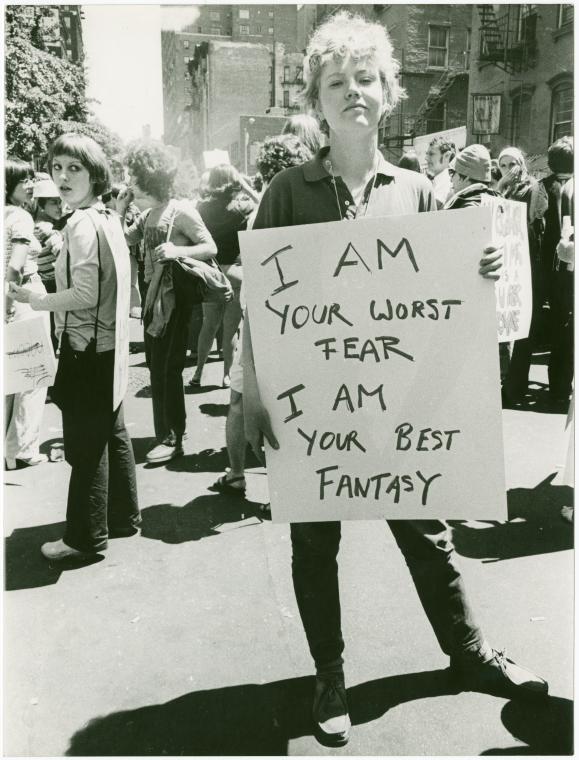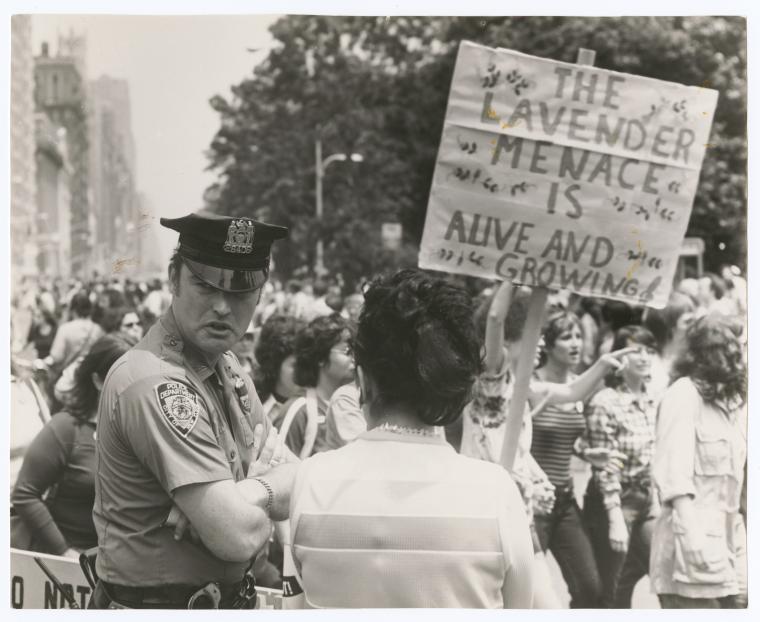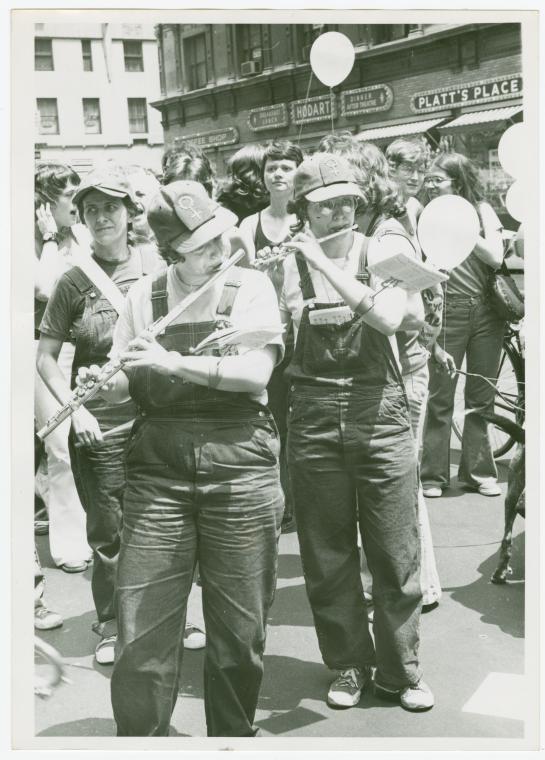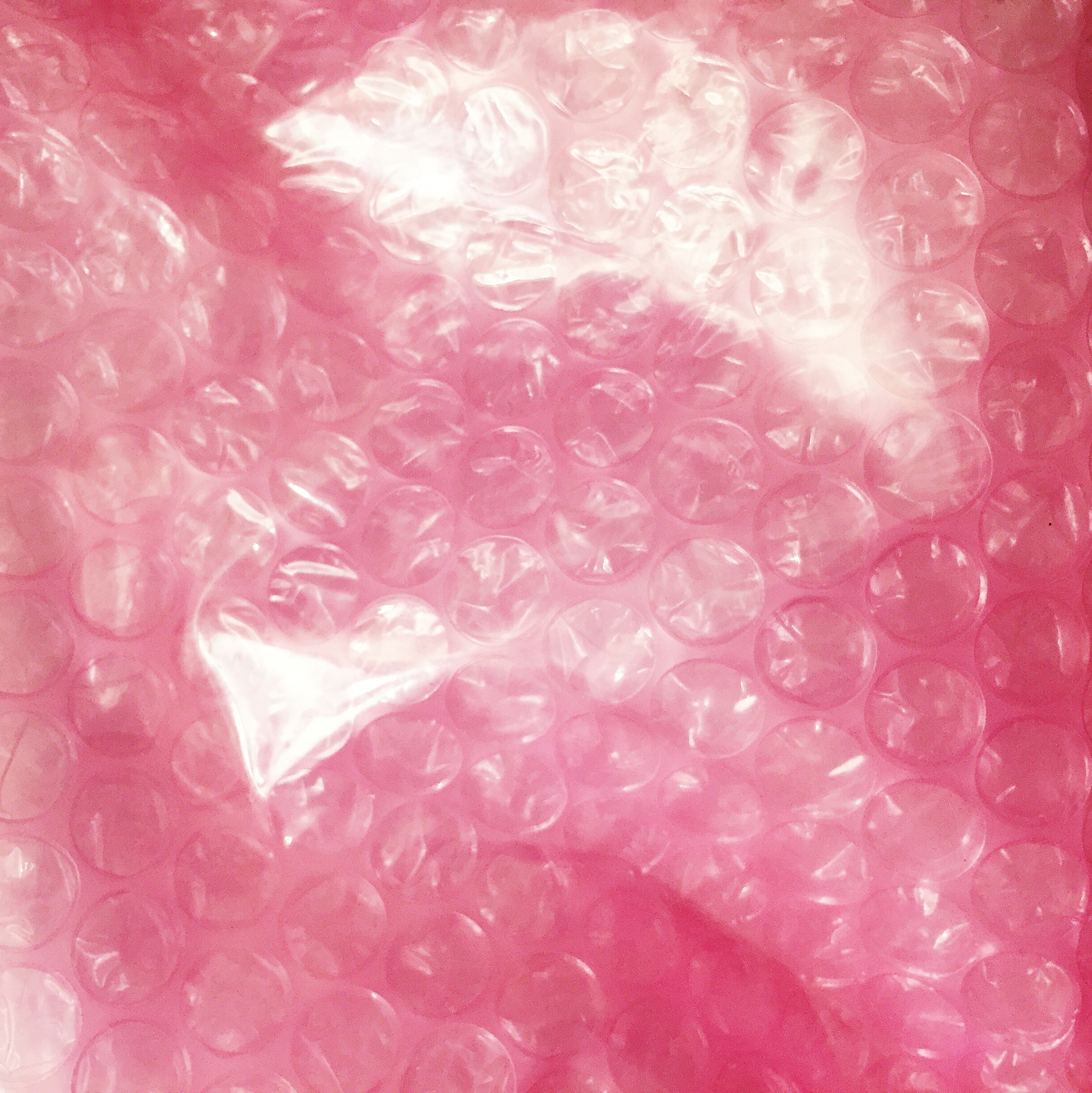Reading the Subversive Stitch on the Eve of the Inauguration
By this point, we’ve moved well beyond the notion that fashion is frivolous. Once the F-word as Valerie Steele so famously wrote, we now accept the fact that fashion should be taken seriously—that fashion is a microcosm for the great spectrum of social and political struggle. Yet, on the eve of the Women’s March on Washington—as my Instagram feed overflows with images of protest signs and Pussyhats while I sit here feeling somewhat ineffectual in Sweden, the socialist safe haven I call home—I feel compelled to politically engage in the only way I know how: through reading and critically reflecting on fashion’s journey from the margins to the mainstream of feminist and political discourse.
In a sense, however, I feel as if I am yelling into an echo chamber. Beyond this fashion-centric media bubble I occupy with you, fashion—and the women’s bodies it adorns—continues to be a political flashpoint. If you've paid attention over the last year, you know that throughout the election cycle, clothing has served as an easy point of entry for speaking about serious issues pertaining to women's roles in positions of power. There was the good—such as Michelle Obama’s resplendent sartorial diplomacy over the past eight years and the ascendance of Pantsuit Nation—as well as the bad—from our new President’s (…shudder) continued degradation of women’s bodies (because, as we know, all bodies are dressed bodies) to Republican Kansas State Senator Mitch Holmes’ misogynist proposal for an 11-point dress code for women senators.
Yet, perhaps more subtly, there’s something about this moment that (I can only imagine) feels reminiscent of the second wave feminism of the 60s and 70s. Once again, we are fighting for the right for agency over our bodies. Appropriately, these concerns have trickled down to our dress practices—or how we adorn these bodies that are suddenly, inexplicably in the political crosshairs. Indeed, there’s been something of a second wave feminist sartorial revivalism in the air with the past few seasons’ move away from the skinny jean, blunt bob, and push up bra, toward high waisted salvaged Levi's, more natural locks (both on our heads and, ahem, elsewhere), and delicate bralettes. Another obvious example is the revival of Dr. Martens combat boots and durable, rubber-soled brogues—footwear that's appropriate for pounding the catwalk as much as the pavement. This less-encumbered manner of dressing signals, perhaps, that women are gearing up (literally) for four years of hard work resisting oppression and effecting change.
This sartorial shift may feel somewhat revolutionary to Millennials who are figuring out how to politically engage for the first time after having come of age during the heady optimism of the Obama years, but as The New York Times recently noted, there is a long relationship between feminism and the other F-word:
For American women, clothing has always provided a means of visual resistance, beginning with those who believed in dress reform, or the right to wear pants, in the 1800s. At the 1963 March on Washington, hundreds of black women opted for denim, overalls and natural hair, resisting sartorial protocol and rejecting expectations. When women showed up at the polls in pantsuits last November, they were not only referring to activists of the past but expressing their support for the first female presidential candidate nominated by a major party.
This relationship, however, has not always been so easy going. Feminists have long struggled with how and to what extent they should engage fashion as a form of resistance in and of itself. Indeed, as Linda M. Scott writes in Fresh Lipstick: Redressing Fashion and Feminism, “American feminism takes a dim view of beauty. Across the spectrum of academic and popular literature, feminist writers have consistently argued that a woman’s attempt to cultivate her appearance makes her a dupe of fashion, the plaything of men, and thus a collaborator in her own oppression.” [1] Yet, as Scott aptly points out, such anti-beauty, anti-fashion rhetoric serves few at the expense of many. The ability to eschew fashion and beauty is the right of the privileged and, as history has shown, it has always been those with “more education, more leisure, and more connections to institutions of power…[who] have been the ones who tried to tell other women what they must wear in order to be liberated.” [2]
While, yes, there is a perhaps coincidental nostalgia for 70s fashion (both of the Punk and bra-burning varieties) running parallel to the present struggle for women’s rights, what’s perhaps so refreshing (if we can seek lightness in this moment of darkness) is that this new wave of feminist revolt is so intersectional. To try to answer the question, “What does a feminist look like?” today is an impossible, and perhaps worthless, pursuit. As Katie Rogers wrote in the Times piece, “What women choose to wear to communicate their myriad beliefs on the day of the march is likely to be as multifaceted as the issues involved.” Or, as Chimamanda Ngozi Adichie said, we should all be feminists, and therefore our sartorial and artistic expressions of feminism should be reflective of our diversity.
Further, with the devastating news that Trump plans to gut funding for the National Endowment for the Arts—an agency that makes up an utterly miniscule .012% of federal spending—the urgency to create, as well as to express ourselves through dress and adornment (for there is no arguing anymore about whether or not fashion is a form of art), is perhaps more acute than ever. Yet, even if funding gets stripped away from essential public art organizations, we must remember that the feminine craft tradition has never been adequately bolstered by formal institutions.
Women, unfortunately, have always been forced to work at the margins—to enter the museum through the back door, so to speak. Moreover, history has again demonstrated its penchant for repeating itself as queer and DIY artistic spaces are threatened by sociopolitical leanings of Trumpism (a point that is movingly addressed in the recent Hurray for the Riff Raff video for their single Hungry Ghost). However, we should feel comforted by the fact that even in what are sure to be lean times, women’s craft and queer artistic expressions will not only survive; they will thrive, paving the way for a new feminist aesthetic and ethos of inclusivity.
The delightfully-named Pussyhat Project stands as case-in-point. A knitting collective born online, the group seeks to create solidarity through craft (and also by sidestepping more capitalistic channels of fashion consumption). Providing only basic instructions, the project permits knitters to customize their Pussyhats, but the color pink is embraced by knitters across the board as a knowing commentary on the power of unmediated feminine resolve.
In thinking about and situating the Pusshyat Project within the history of feminist sartorial expression and political activism—as well as that of the power of craftivism and hacktivism more generally—it’s worthwhile to return to Rozsika Parker’s 1984 feminist history, The Subversive Stitch: Embroidery and the Making of the Feminine. In the first pages of the book, Parker explains that sewing and embroidery (but perhaps also craft more generally) are “inscribed in our social institutions…indelibly associated with [both positive and negative] stereotypes of femininity.” [3] To that end, the Pussyhat Project and others like it are perhaps an unsurprising outlet for feminine political mobilization, for better or for worse. Indeed, on the one hand, it may be argued that women’s penchant for crafting (and perhaps also fashion) is nothing more than a crucial manifestation “of patriarchal ideology, sanctioning a rigid and oppressive division of labor,” or a form of art-making that is less significant than the (masculine) fine arts.[4]
On the other, however, Parker suggests that while second wave feminists scorned craft in an attempt to distance themselves from feminine stereotypes, the contemplative nature of craftwork and the fact that it allows women to escape inside of themselves, “can lead women to an awareness of the extraordinary constraints of femininity, providing at times a means of negotiating them, and at other times provoking the desire to escape the constraints.” [5] Indeed, in a reprint of this (remarkable) volume Parker powerfully quotes artist Kate Walker who explains that "femininity and sweetness are part of women's strength…. [but] quiet strength need not be mistaken for useless vulnerability." [6]
The Times reports that as of January 18, 60,000 Pussyhats had been knit, with perhaps many more being finished up before Saturday’s march(es). The goal of the project was always to create a visual impression of solidarity with all of these pink, pointy Pussyhats captured in aerial drone footage and splashed across social media; with the many tens (and perhaps hundreds!) of thousands reaching completion in these final hours, this goal is sure to be achieved. However, if we consider what Parker says above, the Pussyhat Project may also have another unintended and, if possible more powerful, effect. Indeed, as Parker writes, crafting forces the maker to turn inward, thereby permitting the time and space for deep contemplation. To that end, we should first acknowledge the many hours women and their allies have spent knitting, and then consider the vast amount of brainpower that has been directed toward preparing ourselves for the long battle that lies ahead. It is an incredibly powerful, as well as hopeful, image to keep in mind as we move forward.
Certainly there have been moments over the past couple of months where I (and perhaps you too) have wanted to just give up—or worse, hole up in an underground bunker for the next four years. While I took the necessary time to reflect and to heal in the aftermath of November 8th, however, my writing (my craft) went neglected. For me, writing about fashion has felt so insignificant in comparison to the relentless deluge of bad news I encounter on a near-daily basis. Yet, as we collectively wade into these uncharted waters, we, the writers, designers, performers, and makers of all stripes, must take Rozsika Parker at her word and remember that political activism takes many forms—fashion, in its many manifestations, being one of them.
As someone famously once said, it’s not about the destination, it’s the journey. In our case, however, it may be said that it’s not about the product but the process, and therefore we shouldn’t feel guilty about turning inwards toward our craft during these uncertain times.
Notes
[1] Linda M. Scott, Fresh Lipstick: Redressing Fashion and Feminism (New York: Palgrave MacMillan, 2005), 1.
[2] Ibid. 2.
[3] Rozsika Parker, The Subversive Stitch: Embroidery and the Making of the Feminine (London: The Women’s Press, 1984), 1-2.
[4] Ibid., 3-5.
[5] Ibid., 11.
[6] Rozsika Parker, “Introduction” in The Subversive Stitch: Embroidery and the Making of the Feminine (London: I.B. Tauris, 2010), xiv.





